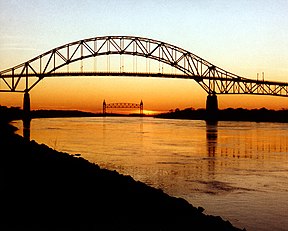Cape Cod Canal
| Cape Cod Canal | |
|---|---|

The Bourne Bridge, with the Cape Cod Canal Railroad Bridge in distance
|
|
| Specifications | |
| Length | 7 miles (11 km) |
| Status | open |
| Navigation authority | United States Army Corps of Engineers |
| History | |
| Original owner | Cape Cod & New York Canal Company |
| Principal engineer | William Barclay Parsons |
| Construction began | June 22, 1909 |
| Date of first use | July 29, 1914 |
| Geography | |
| Start point | Cape Cod Bay |
| End point | Buzzards Bay |
| Length: | 825 ft (251 m) |
| Beam: | 480 ft (150 m) |
| Height: | 135 ft (41 m) |
| Draft: | 32 ft (9.8 m) |
The Cape Cod Canal is an artificial waterway in the state of Massachusetts connecting Cape Cod Bay in the north to Buzzards Bay in the south.
Part of the Atlantic Intracoastal Waterway, the approximately 7 mile (11.3 km) long canal traverses the narrow neck of land joining Cape Cod to the state's mainland. Most of its length follows tidal rivers widened to 480 feet (150 m) and deepened to 32 feet (9.8 m) at mean low water, shaving 135 miles (217 km)s off the journey around the Cape for its approximately 14,000 annual users.
Most of the canal is located in Bourne, Massachusetts, but its northeastern terminus is in the town of Sandwich. Scusset Beach State Reservation lies near the canal's north entrance, the Massachusetts Maritime Academy near its south. A swift running current changes direction every six hours and can reach 5.2 miles (8.4 km) per hour during the receding . The waterway is maintained by the United States Army Corps of Engineers and has no toll fees. It is spanned by the Cape Cod Canal Railroad Bridge and two highway bridges—the Bourne and the Sagamore. Traffic lights at either end govern the approach of vessels over 65 feet (19.8 m).
Although being an artificial waterway, the canal is occasionally used by whales and dolphins including critically endangered North Atlantic right whales and can cause closure of the canal.
The idea of constructing such a canal was first considered by Miles Standish of the Plymouth Colony in 1623, and Pilgrims scouted the low-lying stretch of land between the Manomet and the Scusset rivers for potential routes. William Bradford established the trading post of Aptuxcet in 1627 at the portage between the rivers. Trade with the Native Americans of Narragansett Bay and the Dutch of New Netherland prospered and was a major factor enabling the Pilgrims to pay off their indebtedness. In 1697 the General Court of Massachusetts considered the first formal proposal to build the canal, but apparently took no action. In 1717, a canal called Jeremiah's Gutter was created in Orleans, spanning a narrower portion of the Cape some distance to the East, although it only remained active until the late 1800s. More energetic planning with surveys took place repeatedly in 1776 (by George Washington), 1791, 1803, 1818, 1824–1830, and 1860. None of these efforts came to fruition. The first attempts at actually building a canal did not take place until the late 19th century; earlier planners either ran out of money or were overwhelmed by the project's size.
...
Wikipedia
